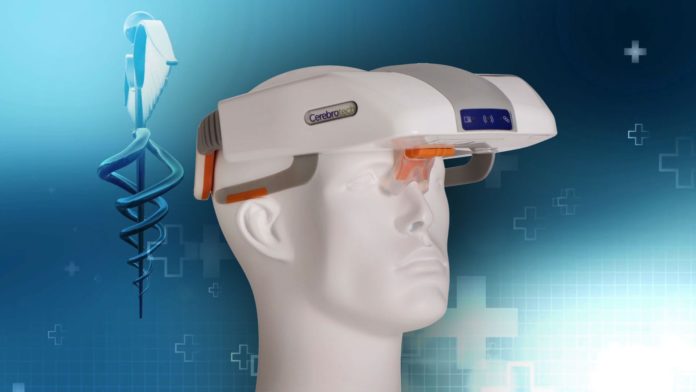Standard physical examination achieved only 40-89 percent accuracy in detecting stroke
A new device worn like a visor can detect emergent large-vessel occlusion in patients with suspected stroke with 92 percent accuracy.
In a study in the Journal of Neurointerventional Surgery, clinical investigators at the Medical University of South Carolina (MUSC), Mount Sinai, the University of Tennessee Health Sciences Center reported that in patients with large-vessel occlusions early detection can ensure they are quickly sent to a Comprehensive Stroke Center with endovascular capabilities.
In contrast, a standard physical examination achieved only 40 to 89 percent accuracy in identifying patients with large-vessel occlusion who could benefit from endovascular therapy.
When a patient is having a severe stroke, the brain’s fluids will change, producing an asymmetry in the radio waves detected by the VIPS device
According to a 2013 article in the Journal of Stroke, “Stroke is one of the leading causes of death and disability in India. The estimated adjusted prevalence rate of stroke range, 84-262/100,000 in rural and 334-424/100,000 in urban areas. The incidence rate is 119-145/100,000 based on the recent population based studies. There is also a wide variation in case fatality rates with the highest being 42% in Kolkata.” Morbidity and mortality because of stroke – which essentially means disruption of blood supply to parts of the brain – is intimately linked to the time lag between the onset of stroke and the patient reaching a medical centre.
The volumetric impedance phase shift spectroscopy (VIPS) device (Cerebrotech VisorTM, Cerebrotech Medical Systems, Pleasanton, CA) works by sending low-energy radio waves through the brain that change frequency when passing through fluids. Such waves are reflected back through the brain and then detected by the device.
When a patient is having a severe stroke, the brain’s fluids will change, producing an asymmetry in the radio waves detected by the VIPS device. The greater the asymmetry, the more severe the stroke.
Endovascular therapy within 24 hours is the standard of care for emergent large-vessel occlusion, but the chance of achieving a good outcome decreases by approximately 20 percent for each hour that passes before treatment.
The researchers hope that the device will save valuable time — especially important in stroke where early intervention can have dramatic effects on outcome. The accuracy of the device simplifies the decision made by emergency personnel about where to take patients first, according to Raymond D. Turner, M.D., professor of neurosurgery and chief of the Neuroscience Integrated Center of Clinical Excellence at MUSC.
“Transfer between hospitals takes a lot of time,” said Turner. “If we can give the information to emergency personnel out in the field that this is a large-vessel occlusion, that should change their thought process in triage as to which hospital they go to.”


